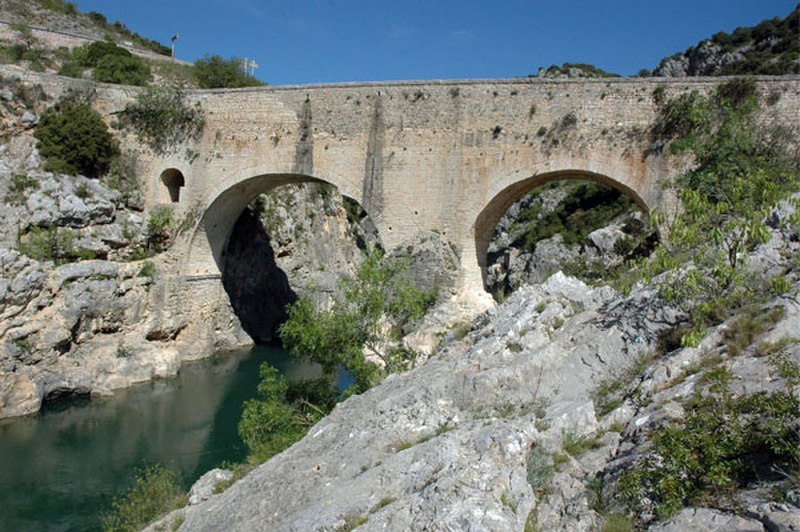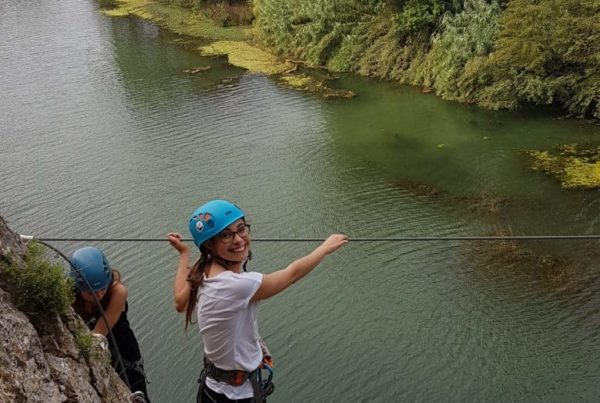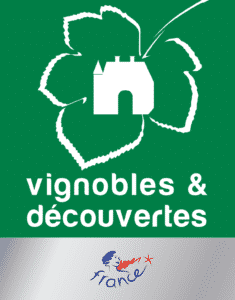We continue our road-trip to the most beautiful villages in Occitanie! Saint-Jean-de-Fos is one of those villages where the cicadas sing in summer and where life is good. Close to tourist attractions such as the Devil’s Bridge, Saint Guilhem le Désert and the Hérault gorges, Saint Jean de Fos is a stopover not to be missed. We visited it for you, and here are a few recommendations and explanations of the history of this village in the upper Hérault valley.
The must-sees in Saint-Jean-de-Fos :
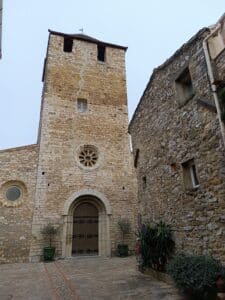
Saint Jean Baptiste church in Saint Jean-de-Fos.
The Saint-Jean-Baptiste church is one of the village’s most emblematic buildings.
It is located in the heart of the village, on the main square. It can be recognized by its square bell tower. Built in the 18th century, the church is an excellent example of the region’s Baroque architecture.
It is dedicated to St. John the Baptist, the city’s patron saint. Once inside, you’ll be struck by the richness of the interior decorations. The vaulted ceiling is adorned with colorful paintings and frescoes depicting scenes from the life of St. John the Baptist.
The walls are also decorated with numerous religious ornaments and wood carvings. One of the church’s most remarkable features is its organ. The organ was built in 1787 by the famous Montpellier organ builders Dupont and Isnard. In addition to its architectural and artistic appeal, the Saint-Jean-Baptiste church is
also an important place of worship for the people of Saint-Jean-de-Fos. Masses are celebrated there regularly, and it is also used for religious events such as weddings, baptisms and funerals. Traditions have thus been perpetuated for over 600 years.
Saint-Jean-de-Fos square
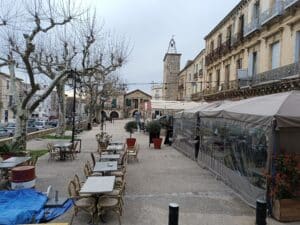
The central square in Saint-Jean-de-Fos, at rest in winter!
The heart of this lively village is the central square. This was built around the Saint-Jean-Baptiste church between 1031 and 1060. Historically, it follows on from the construction of the Devil’s Bridge. The square was laid out in accordance with the wishes of the local abbots. The site was formerly known as “le gouffre noir” (the black abyss), a reference to the legends of the Devil’s Bridge. (Reference article on Saint Guilhem le désert).
In the 12th century, the village square was reinforced with ramparts for the safety of the inhabitants. This gave rise to the village name of “Saint Jean du Fort”, which over the years evolved into the “Saint Jean de Fos” we know today.
On the square, you’ll find everything you need to eat in Saint Jean de Fos, as well as a drink after a hot summer’s day. It’s a peaceful place that makes you feel good. According to a recent study, Saint Jean de Fos is one of the villages in the South of France most appreciated by the French in terms of hospitality. Notably in terms of the pleasantness and diversity of Airbnb accommodations.
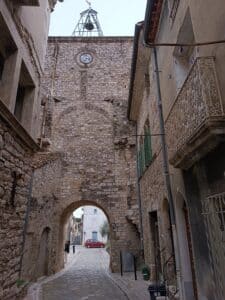
The village fortifications, overlooking the central square.
Saint-Jean-de-Fos, a village of potters :
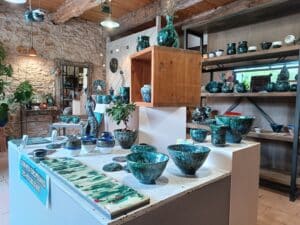
“Le comptoir des oxydes”, one of the many potters’ workshops in Saint-Jean-de-Fos.
The village’s pottery tradition dates back to the 13th century. The village is renowned for its high-quality handmade pottery. This pottery is handmade using traditional methods handed down from generation to generation. It’s called glazed pottery in Saint jean de Fos.
Local potters use local clays to create a variety of pieces. These include vases, plates, bowls, dishes and decorative objects. They are characterized by their bright colors, and original patterns and shapes inspired directly by the surrounding nature.
A museum is dedicated to this craft. It’s a source of pride for the village, where this art has been perpetuated for generations. Here, you can catch a glimpse of the local history of pottery and its close ties with the local people. Exceptional pieces are on display. Every year, on the first weekend in August, one of the region’s biggest pottery markets is held here.
the Argileum, the clay museum!
The Argileum is a museum dedicated to clay, an abundant natural resource in the region, and its many uses in crafts and industry. The museum offers an interactive experience for visitors of all ages with guided tours. Permanent and temporary exhibits present the history of clay. We talk about its different properties, and its traditional and modern uses in the region. The museum also offers practical activities for visitors, such as creating ceramics, pottery, sculpture or clay painting. Fun workshops for children and adults are organized in the form of courses throughout the year. These workshops are supervised by local artisans from Saint Jean de Fos.
The Devil’s Bridge
Also part of the commune of St Jean de Fos, the Devil’s Bridge is just a 5-minute walk from the village square. Pedestrian access leads from the village to the banks of the Hérault. Here, you can relax by the water’s edge on a huge pebble beach overlooking the bridge. According to recent research by the University of Montpellier, the bridge was built in 873. It was built on the initiative of the two major local abbeys, Aniane and Val de Gellone in Saint Guilhem le Désert.
Legend has it that it was built by the devil himself to make it indestructible. The pact made with the Devil was an exchange of services. Saint Guilhem, protector of the site, agreed to give the Devil the first soul to cross the bridge. St Guilhem foiled the plan by sending a bone across the bridge, so that a stray dog would be the first soul offered to the Devil. The angry devil plunged into the Hérault, creating the “devil’s hole”.
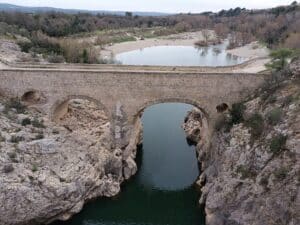
The Devil’s Bridge! A place not to be missed, full of legend.
Sports activities around Saint jean de Fos
Located in an exceptional natural environment, St Jean de Fos offers a wide range of sporting activities for outdoor enthusiasts and experienced sportsmen and women alike. The playground is also ideal for introducing families and friends to outdoor sports.
– Hiking: The village has a number of hiking trails that allow you to discover the landscapes of the Hérault valley. The Devil’s Bridge discovery trail is an easy, accessible hike for the whole family.
For the more experienced hiker, the GR7 crosses the commune and offers numerous routes for exploring the Cévennes.
– Mountain biking: Saint-Jean-de-Fos has a number of signposted routes for mountain bikers. There are routes of varying levels to discover the surrounding area, from the Hérault valley to the Cévennes. The commune’s mountain bike trails are accessible all year round, and offer an ideal playground for experienced mountain bikers. Further information is available from the tourist office at the Maison du Grand Site de France.
– Climbing: The cliffs of St Guilhem le Désert, just a few kilometers from St Jean de Fos, are a major climbing site, renowned for their technical and varied routes. There are some great routes on the north face, as well as a multitude of sport routes on the south faces, which are very popular in winter.
Activities on the water…
– Canoeing: The Hérault gorges are ideal for canoeing. However, canoeing is not permitted in all gorges. You can hire boats and enjoy the sections of the river upstream of Saint Guillhem le désert and downstream of the Devil’s Bridge. The middle section, known as P4, is only authorized for professionally supervised whitewater activities such as canyoning.
– Canyoning: This recently fashionable activity is booming in the region. The canyon du diable course is ideal for discovering this activity. Basically, it’s a river descent made all the more fun by crossing vertical waterfalls of varying heights. You can try your hand at jumping, abseiling and whitewater swimming!
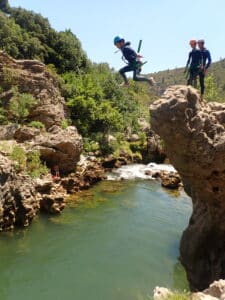
Canyoning just 2 km from Saint- Jean-de-Fos!
The underground wonder of the Clamouse cave
Also located in Saint Jean de Fos, Clamouse is one of France’s most beautiful caves. Listed as a natural site since 1942, it attracts thousands of visitors every year. The Clamouse cave is renowned for its remarkable geological formations. It is home to numerous stalactites, stalagmites, draperies and other calcite formations that have been sculpted over time by water and minerals.
Guided tours are available every day at different times of the day. The name “Clamouse” comes from the Languedoc word “Clamousa”, meaning “clamorous”, “howling” or “weeping”. This adjective is due to the noise made by the water under the ground during floods or Cevennes episodes. Another sad legend tells us that a shepherd working on the Causse used to send a ewe from his flock to its mother by throwing it into an abyss in the Causse. It turned out that the resurgence flowed down into the Hérault. One day, the shepherd stumbled while trying to throw a more impetuous goat and fell into the abyss himself. Since then, his mother has mourned his loss at the entrance to the caves.
This legend relates the fact that at the time, the local population was already aware of the direct relationship between the surrounding plateaux and the underground conduits or resurgences.
Our article on Saint-Jean-de-Fos is coming to an end! This month we’ll be continuing our tour of the wonders of our region, sharing them with you with our great passion.
We look forward to seeing you at our events or in our news letter!

